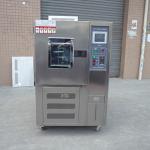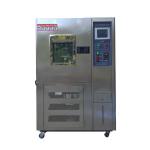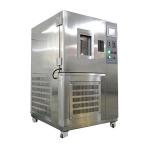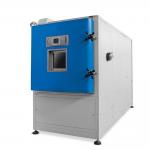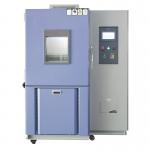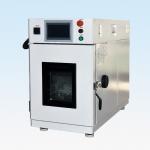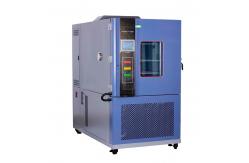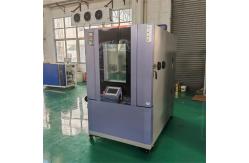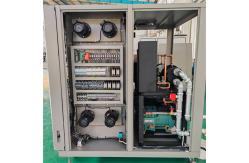In the electronics industry, where technological advancements occur
at a breakneck pace, ensuring the reliability and durability of
electronic components and devices is non-negotiable. The Customized
Climate Chamber Programmable for Electronics Industry emerges as a
cornerstone of quality assurance, providing a meticulously
controlled environment for comprehensive testing. This state-of-the-art chamber is purpose-built to evaluate the
performance and resilience of a vast array of electronic products,
including circuit boards, semiconductors, consumer electronics, and
industrial control systems. It caters to electronics manufacturers,
research institutions, and quality control laboratories. The
primary objective is to subject these products to a spectrum of
programmable temperature, humidity, and other environmental
conditions, simulating the diverse and often harsh scenarios they
will encounter during their lifecycle. By doing so, potential
weaknesses can be identified and rectified, leading to enhanced
product quality, prolonged lifespan, and increased customer
satisfaction. - Ergonomic and Space-Efficient Design
- The chamber is constructed with a lightweight yet robust aluminum
alloy framework, ensuring structural integrity while facilitating
easy installation and relocation. The exterior is clad in a
corrosion-resistant, electrostatically dissipative material,
safeguarding against environmental degradation and electrostatic
interference. The interior is lined with a thermally conductive and
chemically inert material, promoting uniform temperature
distribution and preventing any adverse reactions with the tested
electronics. The door is engineered with a triple-seal mechanism,
incorporating a high-precision silicone gasket and a magnetic
locking system, maintaining an airtight and stable testing
environment. A generously sized, anti-reflective viewing window,
made of tempered glass, affords clear visual inspection without
compromising the internal conditions. The chamber's interior layout
is optimized with adjustable shelves and racks, capable of
accommodating various sizes and shapes of electronic samples, from
diminutive microchips to sizable server racks.
- Precision Programmable Environmental Control Systems
- Temperature Control: Capable of spanning a wide temperature range,
from -70°C to +180°C, with an astounding accuracy of ±0.2°C. It
harnesses a combination of vapor compression refrigeration and
resistive heating, integrated with a high-resolution PID
(Proportional-Integral-Derivative) control algorithm. The control
system is furnished with an array of platinum resistance
temperature detectors (RTDs), strategically positioned throughout
the chamber, ensuring minimal temperature gradients. The
user-friendly touchscreen control panel permits the facile
programming of intricate temperature profiles, including ramping
rates as steep as 5°C per minute, extended soak periods lasting up
to several weeks, and cyclic temperature sequences with precise
dwell times and transition rates. This level of programmability is
essential for replicating real-world temperature variations, such
as those experienced during device operation, storage in extreme
climates, or transportation across different geographical regions.
- Humidity Control: The humidity control system is equally
sophisticated, capable of achieving humidity levels ranging from 0%
to 100% RH (Relative Humidity), with an accuracy of ±1% RH. It
employs a hybrid system of ultrasonic humidifiers and molecular
sieve dehumidifiers, synchronized with a laminar flow air
circulation design. The chamber is equipped with capacitive
humidity sensors that offer rapid response times and high accuracy.
The control system enables the programming of dynamic humidity
profiles, including step changes, linear ramps, and sinusoidal
oscillations, mimicking the humidity fluctuations that electronics
may encounter, such as in humid tropical environments or during
rapid transitions between indoor and outdoor conditions.
- Programmable Environmental Profiles: The chamber's control software
allows for the creation and execution of highly complex
environmental test sequences. Users can define not only temperature
and humidity profiles but also incorporate other parameters such as
pressure, light intensity, and gas composition. For example, a test
sequence can simulate the high-altitude, low-pressure environment
combined with temperature cycling and specific humidity levels to
evaluate the performance of avionics electronics. The software also
supports conditional branching and looping, enabling the execution
of different test segments based on the real-time readings of the
sensors, providing a level of flexibility and customization that is
invaluable for comprehensive electronics testing.
- Advanced Instrumentation and Data Acquisition
- The chamber is outfitted with a comprehensive suite of sensors and
instrumentation. In addition to temperature and humidity sensors,
it includes sensors for measuring electrical parameters such as
leakage current, impedance, and power consumption of the tested
electronics. Optical sensors can be integrated to monitor light
emission or absorption characteristics of optoelectronic
components. These sensors are interfaced with a high-speed data
acquisition system that records and stores all relevant data. The
data acquisition system offers a sampling rate of up to 10,000
samples per second, ensuring that even the most transient and
minute changes in environmental conditions or product performance
are faithfully captured. The collected data can be accessed and
analyzed in real-time using the integrated software suite or
exported in industry-standard formats for further in-depth
analysis. The system is also compatible with leading electronics
design and analysis software, facilitating seamless integration
into existing R&D and quality control workflows.
- Enhanced Safety and Compliance Features
- The Customized Climate Chamber Programmable for Electronics
Industry is engineered with multiple layers of safety features. It
incorporates a redundant safety shutdown system that activates
instantaneously in the event of any critical malfunction, such as
overheating, overcooling, or excessive humidity. The chamber is
equipped with a fire suppression system, utilizing inert gases or
chemical suppressants, which can rapidly extinguish any incipient
fires that may arise due to electrical faults or component
failures. The ventilation system is designed to expel any
potentially harmful gases or vapors generated during testing,
safeguarding both the samples and the operators. The control panel
is fortified with safety interlocks and prominent warning
indicators, preventing unauthorized access and ensuring the
well-being of personnel. Additionally, the chamber complies with a
comprehensive suite of electronics industry standards and
regulations, including IEC 60068 for environmental testing, JEDEC
standards for semiconductor testing, and various OEM-specific
requirements, ensuring that the testing procedures are both
recognized and accepted by regulatory bodies and industry peers,
thereby streamlining the product certification process.
- Chamber Size and Capacity: Available in a diverse range of sizes, from compact benchtop
models with a volume of a few liters, ideal for testing individual
microelectronics components, to large floor-standing units with
volumes exceeding several cubic meters, suitable for evaluating
entire racks of server equipment or large-scale industrial control
systems. The interior dimensions are meticulously engineered to
optimize air circulation and ensure uniform distribution of
environmental parameters. For instance, a mid-sized chamber might
feature interior dimensions of 1.5 meters x 1.5 meters x 2 meters,
providing ample space for testing multiple circuit boards or a
small assembly of consumer electronics devices while maintaining
precise environmental control.
- Temperature Cycling Rate: Capable of executing temperature cycles at a rate of 4 to 10
cycles per hour, depending on the specific test protocol. For
example, it can swiftly transition from +120°C to -60°C in a matter
of minutes and then reverse the cycle, subjecting the electronics
to severe thermal stress. The ramp rate can be adjusted within a
wide range, from 1°C per minute to 20°C per minute, allowing for
the emulation of diverse thermal profiles, such as the rapid
heating and cooling experienced during power cycling of electronic
components or the gradual temperature changes in long-term storage
conditions.
- Humidity Cycling Rate: The humidity can be cycled within 5 to 15 minutes, enabling the
simulation of rapid moisture level changes. This is crucial for
testing the effects of sudden environmental transitions, such as
when an electronic device is moved from a dry, air-conditioned room
to a humid outdoor environment. The chamber can precisely adjust
the humidity level from a bone-dry 0% RH to a saturated 100% RH and
back, with seamless transitions and minimal overshoot or
undershoot, ensuring accurate and repeatable testing.
- Programmable Test Sequence Length and Complexity: The chamber's control software supports test sequences of
virtually unlimited length, allowing for extended durability and
reliability testing that can span months or even years. The
complexity of the sequences is limited only by the user's
imagination and the requirements of the test. Multiple
environmental parameters can be simultaneously varied and
coordinated, and conditional statements can be incorporated to
adapt the test based on the real-time performance of the sample.
For example, a test could start with a mild temperature and
humidity profile and then gradually increase the stress levels
based on the electrical performance of the device under test,
providing a highly realistic and comprehensive evaluation of the
product's robustness.
- Data Acquisition Rate: The data acquisition system samples sensor data at a rate of 8000
samples per second, guaranteeing the capture of the most fleeting
and subtle changes in temperature, humidity, electrical parameters,
and other measured variables. This high sampling rate is essential
for detecting transient events, such as short-duration electrical
spikes or rapid environmental fluctuations, which could have a
significant impact on the performance and reliability of electronic
components. The acquired data is stored in a lossless format,
ensuring its integrity and availability for detailed post-test
analysis.
- Compliance with Industry Standards: The chamber is fully compliant with IEC 60068, which encompasses
a wide range of environmental testing methods and procedures for
electronics. It also adheres to JEDEC standards for semiconductor
testing, ensuring that the testing of integrated circuits and other
semiconductor devices is conducted in accordance with industry best
practices. Additionally, it meets various OEM-specific standards,
such as those imposed by leading electronics manufacturers for
their supply chain quality control, facilitating seamless
integration into the existing quality assurance frameworks of the
electronics industry.
- Accurate Simulation of Electronics Operational Environments
- The primary function of this chamber is to offer a highly accurate
and realistic simulation of the environmental conditions that
electronic products will face throughout their lifecycle. By
precisely programming temperature, humidity, and other parameters,
it allows for the evaluation of how components and devices will
perform and degrade over time. For example, it can determine if a
computer's hard
|
